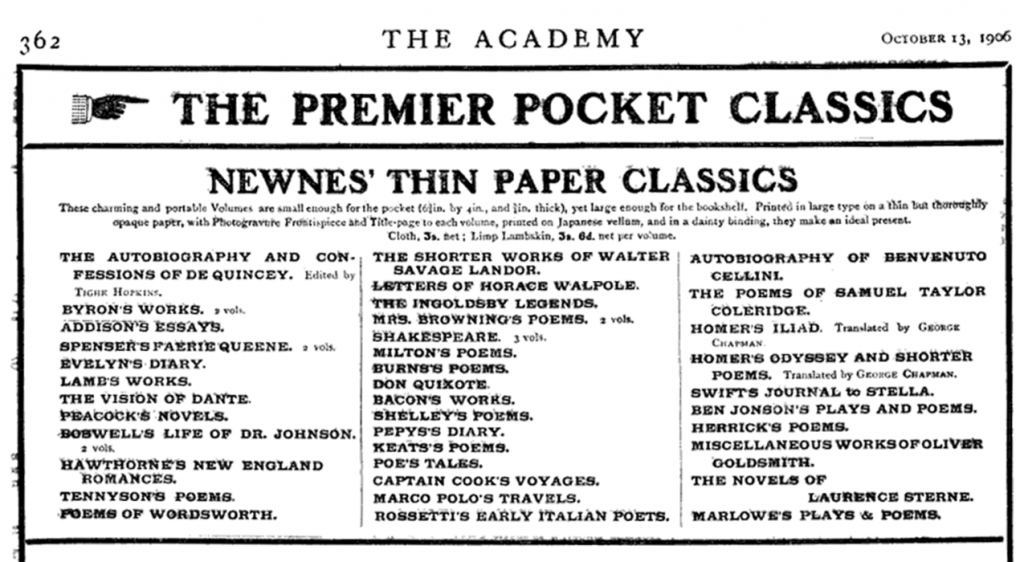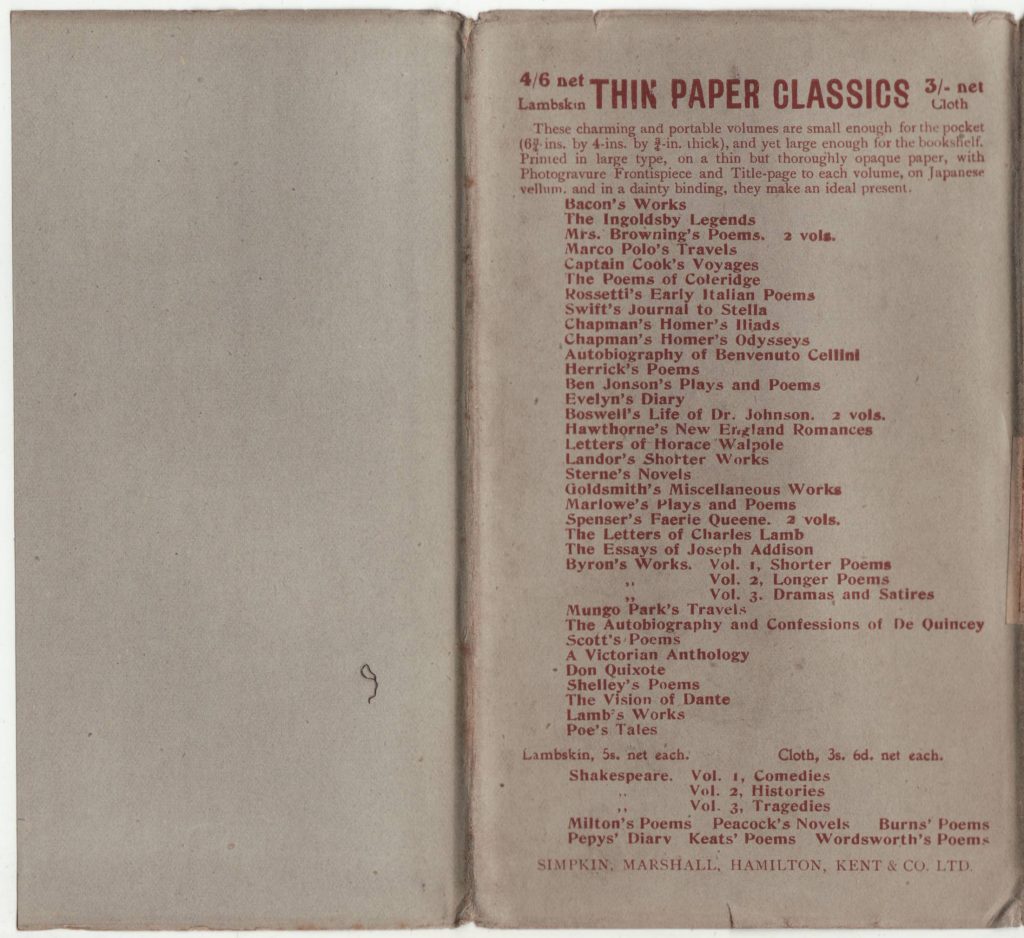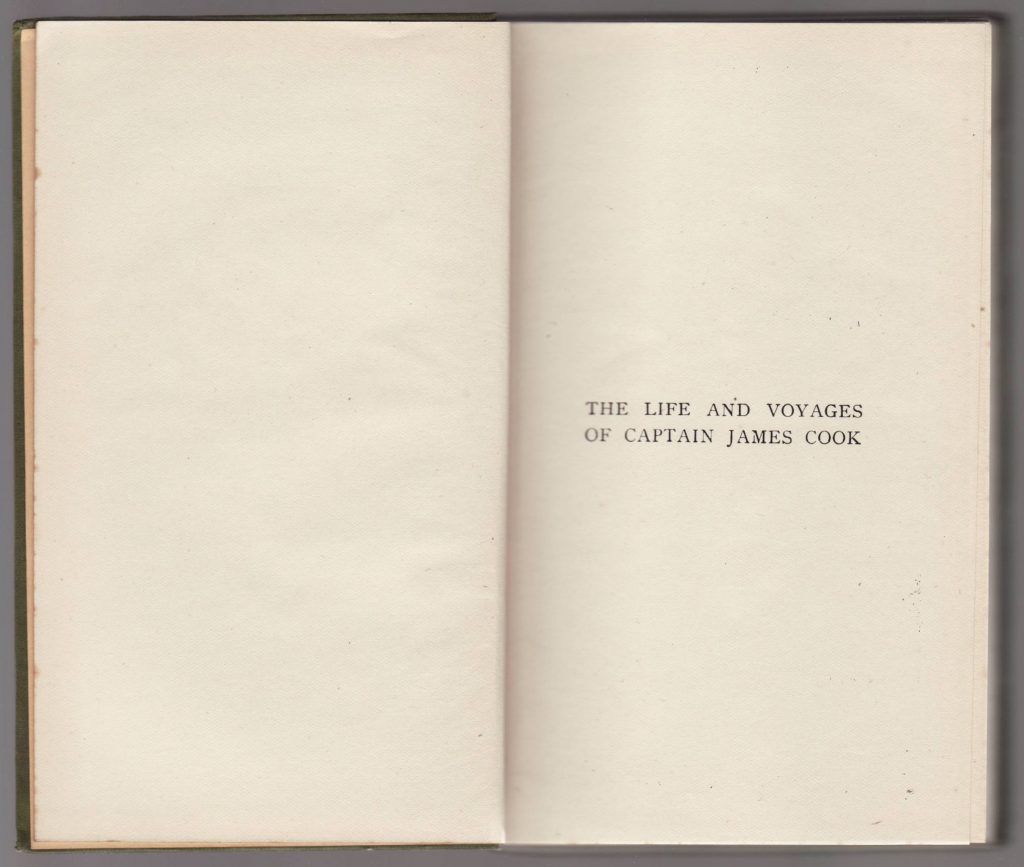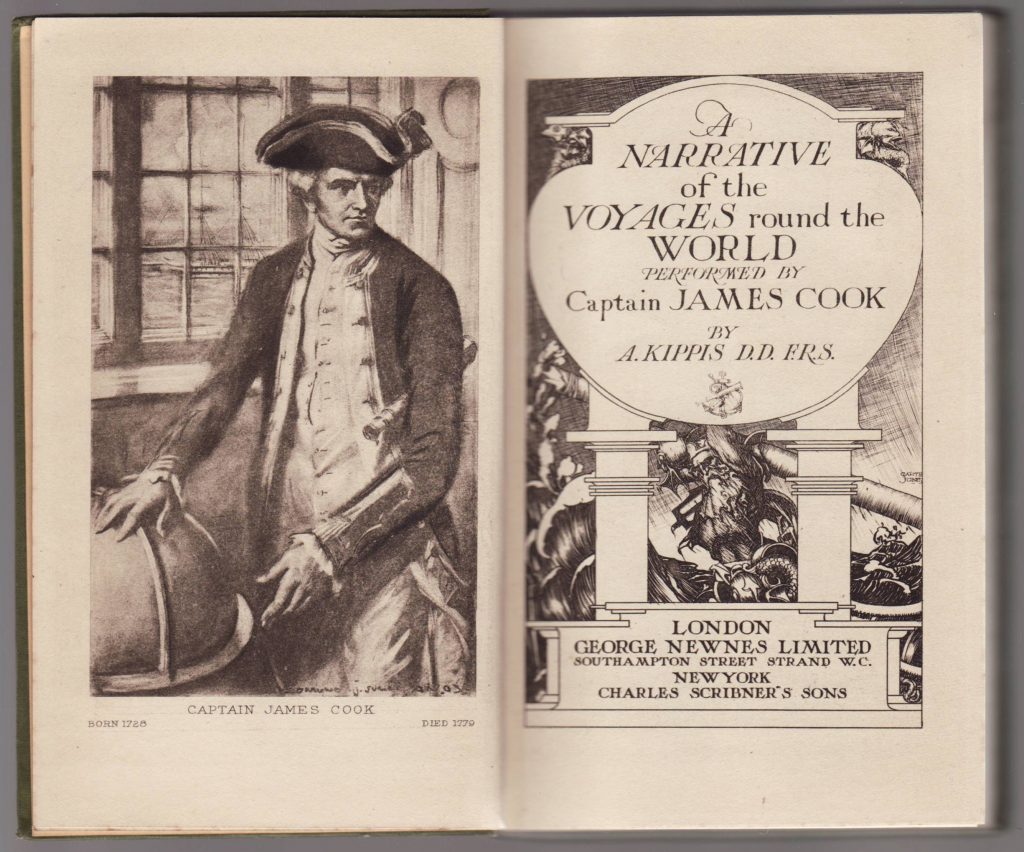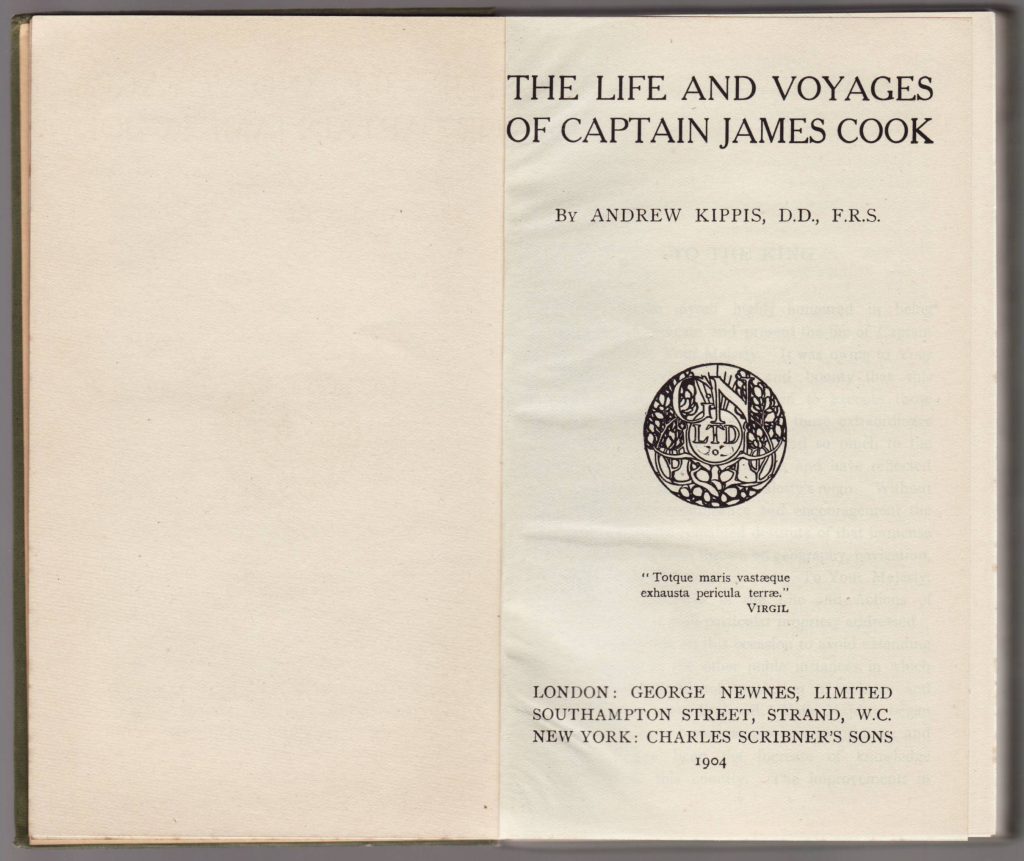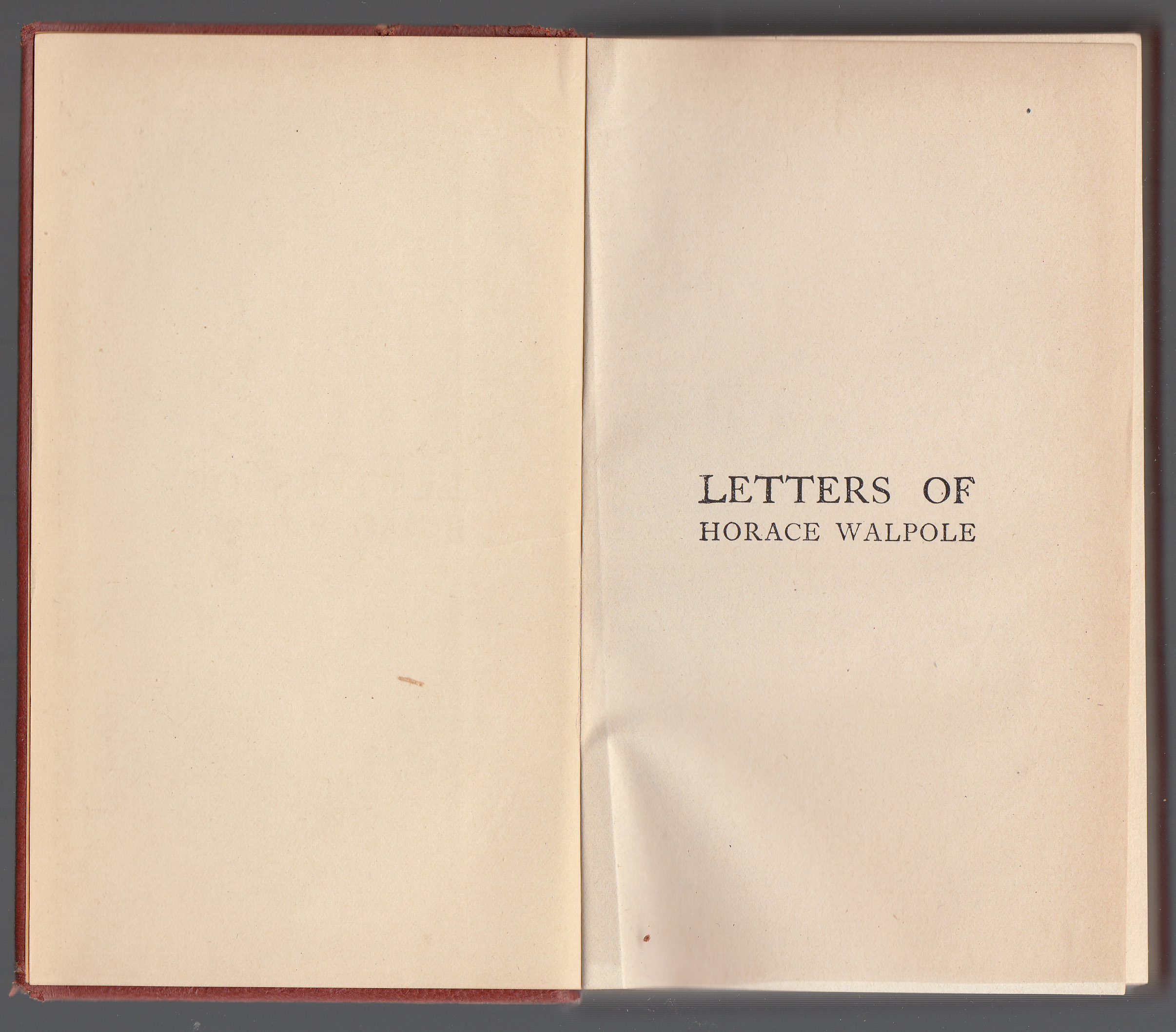aka/ Newnes Thin Paper Classics
aka/ Thin Paper Editions
aka/ Newnes Thin Paper Editions
aka/ Caxton Series
George Newnes Ltd. (London, UK)
Series dates: 1901-1907
Size: 4″ x 6.5″
Charles Scribner’s Sons (New York, US)
Series dates: 1904-1909, 1924-1934
Size: 4″ x 6.5″
Simpkin, Marshall, Hamilton, Kent & Co., Ltd. (London, UK)
Series dates: 1924-1934
Size: 4″ x 6.5″
As noted in the introduction to the Caxton Series, “Newnes was a successful publisher of popular literature, including the Strand Magazine and Tit-Bits and other popular periodicals. Famous authors such as Conan Doyle, H.G. Wells, and P.G. Wodehouse were published in Newnes periodicals and later published popular collections with the firm. Newnes also published books, many practical and how-to books, popular classics and contemporary throw-away literature.”
Around the turn of the century, Newnes began issuing literary series that were a significant step up (in content and form) from the books he published previously. New series included the Thin Paper Classics, Thin Paper Novels, and Caxton Series. The Thin Paper Classics appear as the Thin Paper Editions in the advertisement below (October 1903), and that name seems to be used around the same time for what seems to eventually become the Thin Paper Classics.
At least initially, the distinction between these series was thus: The Caxton Series was on normal paper and included illustrations; The Thin Paper Classics (or Editions) were on thin paper without illustrations, and the Thin Paper Novels were more modern titles on thin paper without illustrations. This distinction, if accurate for the start of these series, seems to become muddled soon after. The books themselves have no indication of the series name, which is only on the jackets, and this contributes to the confusion.
An advertisement from The Sphere from November 1903 advertises the series with 14 titles in two binding styles (lambskin and cloth).
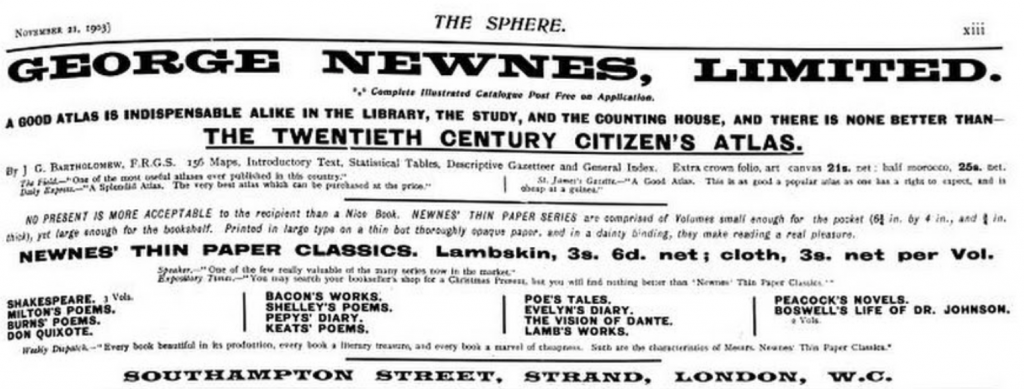
An advertisement from The Academy from December of 1905 lists titles in the Thin Paper Classics, Caxton Series and Pocket Classics. There is no sign of the Thin Paper Novels:
An advertisement from The Academy from October of 1906 is from near the end of the series availability and lists 38 titles. The series reached at least 41 titles. At least the advertising for the series ceases in 1907. Most of the turn of the century literary series initiated by Newnes seemed to be discontinued by the publisher in the 1905-1910 time frame.
As is not uncommon with publisher’s reprint series, Newnes’ Thin Paper Classics and Caxton Series were sold by more than one publisher. Scribner’s sold the series under both the Caxton and Thin Paper Series and Caxton Thin Paper Series names.
As is also not uncommon with publisher’s reprint series, a series can be sold to another publisher. In the case of the Thin Paper Classics (and Caxton Series), Newnes seems to stop advertising and selling the series in 1907. But the series appears again in 1924 under the imprint of Simpkin, Marshall, Hamilton, Kent & Co. Ltd. The titles were viable enough literary property to make them viable to reprint once again more than a decade after they were discontinued by Newnes. Scribner advertised both series until around 1909 when they too seem to have discontinued the series. With Simpkin (et al.) restarting the series in 1924, Scribners begins selling the series once again in the U.S.
The Life and Voyages of Captain Cook is dated 1904 but printed after 1920 (and probably mid-1920s, when the price of the series rose).
Simpkin seems to have printed the books from the original plates from Newnes and left everything in the body of the book itself the same (including the publisher’s imprint). The jackets were minimally updated to include the new publisher’s imprint and colophon but retained the overall look of the Newnes series jackets. The jackets are common to the series. The price is printed on the jacket spine, here updated from 3/- to 3/6 with a sticker. The front jacket flap is blank.
The rear of the jacket advertises the series and includes 41 titles in two different binding styles.
The binding designs are extravagant, with a combination of gold type and debossed designs that are similar to the art nouveau designs used in the earlier Newnes’s series. There does seem to be variation in the design of the bindings from title to title, both during the Newnes era and the Simpkin era. The book includes the Simpkin imprint.
Exuberant designs fill the front and rear endpapers, following the general feel of the designs on the binding.
The half-title page:
A frontispiece illustration (the only one in the book) faces the first of two (!) title pages. From this point on, the book is printed directly from the earlier Newnes series plates: the Newnes and Scribner imprint is on this particular title page (there is no Simpkin imprint in the book).
The second title page follows, and this too includes the Newnes and Scribner imprint, as well as the date of 1904. It seems a bit peculiar that Simpkin did not at least modify the publisher’s imprint on this second title page. The date is also wrong, probably meaning the plates were from the last printing of the series by Newnes.
There is no copyright indication nor date on the page after the second title page:
Scribner was the U.S. publisher of the Caxton Series and Thin Paper Classics when published by Newnes (1901-1907) and Simpkin, Marshall, Hamilton, Kent (1924-1934). The copy of The Letters of Horace Walpole is undated, by printed most likely in the 1924 to 1930 time frame. The title was originally issued in the series by Newnes and Scribner’s in 1904. Jackets are common to the series with minimal information. The jacket spine includes the book’s title, its binding (Lambskin) and US publisher, Scribners. The jacket front includes the book title and series name and a small publisher’s collophon. The front jacket flap is blank.
The rear of the jacket advertises the series, adding the Lambskin designator. I’m not sure if these titles were all available in Lambskin binding, or also in cloth. There is no price for the books. Of the titles listed, several (marked * ) are out of print.
The binding is in lambskin and has held up well for its age. Elaborate gold decorations cover the spine and front of the book. The design is similar to that on copies of Newnes Thin Paper Classics but differs from the Simpkin, Marshall, Hamilton, Kent copy above. Scribners is indicated on the book spine.
The elaborate endpaper design is the same as on the Simpkin, Marshall, Hamilton, Kent copy above. From this point forward, the book is largely the same as the Simpkin, Marshall, Hamilton, Kent copy above.
The half-title page:
A portrait facing the first, elaborately designed title page. Both Simpkin (et al.) and Scribner’s are indicated in the publisher’s imprint.
“Printed in great Britain” faces the 2nd title page, sans illustration, but also with the Simpkin (et al.) and Scribner imprints.
“Printed in Great Britain by the Boltoph Printing Works, Gate Street, Kingsway, W.C.2.”
The printer is noted again on the final page of the book.


